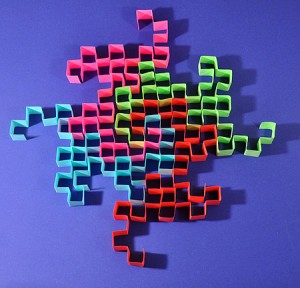As you’re walking along Harwood Street, take a very close look at the glossy leaves of what I was told by one tour participant are magnolia trees all along one side of the street. You should see something roughly like this [but I would love a high-res picture of one of the actual leaves there, showing the full leaf in crisp focus, to replace this stock photo, if somebody could send me one.]

What you can observe, especially in the upper right of this photo, is a series of similar shapes formed by the veins of the leaf, repeating on smaller and smaller scales toward the edge of a leaf. This type of pattern with the self-similarity of the same motif repeating at a series of scales is called a fractal, and we see such patterns over and over again in nature: in the branching patterns of trees, in the leaves of a fern, in the air channels of a lung, even in the contours of mountains. How does that pattern arise? Why do we see that in a leaf?
The basic mechanism at play here is that the tree needs to provide circulation to all parts of the leaf, to provide nutrients and to collect the products of the leaf’s photosynthesis. That circulation travels along the veins of the leaf. But a vein is basically a linear, or 1-dimensional structure; whereas the leaf spans a surface, or a 2-dimensional structure. So there seems to be a fundamental mismatch, and the tree would seem to have a problem nourishing the entire leaf.
However, as the image below shows, it is possible to twist, wiggle, or fold up a linear structure (in this case, a strip of paper) so that it starts to cover or at least come near nearly every point across a surface.  This particular structure is known to mathematicians as the “dragon curve”, and if we made finer and finer versions of it with more and more folds it would come closer and closer to actually covering the surface of a table.
This particular structure is known to mathematicians as the “dragon curve”, and if we made finer and finer versions of it with more and more folds it would come closer and closer to actually covering the surface of a table.
When you take a linear structure and fold it like this, it starts to take on some characteristics of the higher dimensional structure that it is occupying. So much so that, in a certain mathematically measurable and precise way, it takes on a fractional dimension between 1-dimensional and 2-dimensional. That’s where the word “fractal” comes from — it refers to the FRACTional dimensionALity of these types of structure.
That’s why you see them in natural settings like this leaf. The tree, faced with the task of circulation to a 2-dimensional leaf using 1-dimensional veins, has naturally evolved a repetitive, self-similar structure spanning multiple scales, i.e. a fractal, to bridge the gap between these dimensions.

